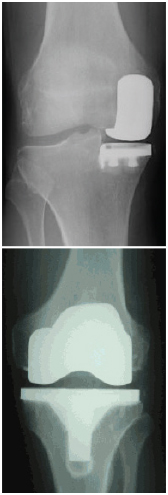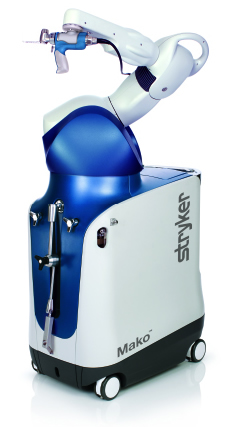Robotic Knee Replacements
Austin Crow, MD
Orthopedic Surgery & Sports Medicine
Chippewa Valley Orthopedics & Sports Medicine
Altoona
 What is a knee replacement?
What is a knee replacement?
When the cartilage surfaces of the knee become damaged,
patients will begin to experience pain and stiffness of the joint. Physicians will treat this pain and stiffness with anti-inflammatory medications and injections, physical therapy, bracing, and activity modification. Unfortunately, arthritis tends to be a progressive disease and often the symptoms will no longer be adequately controlled with these treatment options. At that point, once the patient has failed conservative measures, they would be a candidate for a knee replacement.
A partial knee replacement is when only a portion of the knee is replaced with metal surfaces and a plastic insert is placed to articulate between these two components. These patients must have arthritis that is localized to only one area of the knee to be a candidate for a partial replacement. Conversely, a total knee replacement is when all portions of the knee are removed and replaced, generally the undersurface of the kneecap is replaced with a plastic “button” as well. The technical challenge for both of these surgeries is to align these components in correct orientation and spacing to allow the “new knee” to move in a stable pattern with full range of motion.
What makes a Mako Robotic Knee
Replacement different?
Traditionally, total knee replacements have been performed with guides that either go through the bone or around the leg and allow the surgeon to cut the ends of the bone in the desired position to have a stable knee with full range of motion. This technique relies on these guides to give approximate locations for bone resection but there is a margin of error. This technique has been used by surgeons for decades but recent advancements in robotics and visual recognition software has allowed more precise resection of bone, which ultimately leads to improvements in the accuracy and reproducibility of knee replacements.
This begins with a CT scan of the leg to obtain a very precise “map” of the bones. This information is uploaded to the computer and the surgeon can then plan the replacement before the surgery even begins. Once the surgery does begin, the surgeon needs to “register” the
anatomy of the knee to allow the robot to
know where it is in space. After this takes
place, the robot now knows both the exact
shape and location of the knee. The surgeon
then uses a robotic arm, under direct
surgeon control, to resect the bone
according to the pre-operative plan.
Multiple studies have confirmed the ability
of this technology to very accurately
perform joint replacements with precision
that has not been possible before.
What is our experience with
the Mako Robot at OakLeaf Surgical Hospital?
 OakLeaf Surgical Hospital purchased a Mako Robot in 2016, which is used for both hip and knee replacements. All of the arthroplasty surgeons at Chippewa Valley Orthopedics have been certified in its use. As of the time this article was written, we have completed nearly 200 replacements using the Mako Robot. Our patients have done well, with the vast majority of them going home the day after surgery. We recently began the Fast Track Recovery Program in which a select group of patients are discharged home the same day as their surgery. The use of the Mako Robot during joint replacement is an integral part of our Fast Track Recovery Program.
OakLeaf Surgical Hospital purchased a Mako Robot in 2016, which is used for both hip and knee replacements. All of the arthroplasty surgeons at Chippewa Valley Orthopedics have been certified in its use. As of the time this article was written, we have completed nearly 200 replacements using the Mako Robot. Our patients have done well, with the vast majority of them going home the day after surgery. We recently began the Fast Track Recovery Program in which a select group of patients are discharged home the same day as their surgery. The use of the Mako Robot during joint replacement is an integral part of our Fast Track Recovery Program.
Mako robotic assisted joint replacement is a sophisticated, technological advancement that allows for improved accuracy of component positioning which in turn allow for improvements in pain relief, joint stability, range of motion and longevity of the joint replacement. OakLeaf Surgical Hospital continues to lead the region in orthopedic innovation by providing patients who are undergoing hip and knee replacements the opportunity to have their surgeries performed using the Mako Robot to help improve the results of
their operation.
Dr. Crow – Chippewa Valley Orthopedics & Sports Medicine
For information or to schedule an appointment:
715-832-1400 | 800-322-1747 | cvosm.com
Dr. Crow sees patients in Altoona, Chippewa Falls, Rice Lake and Shell Lake.